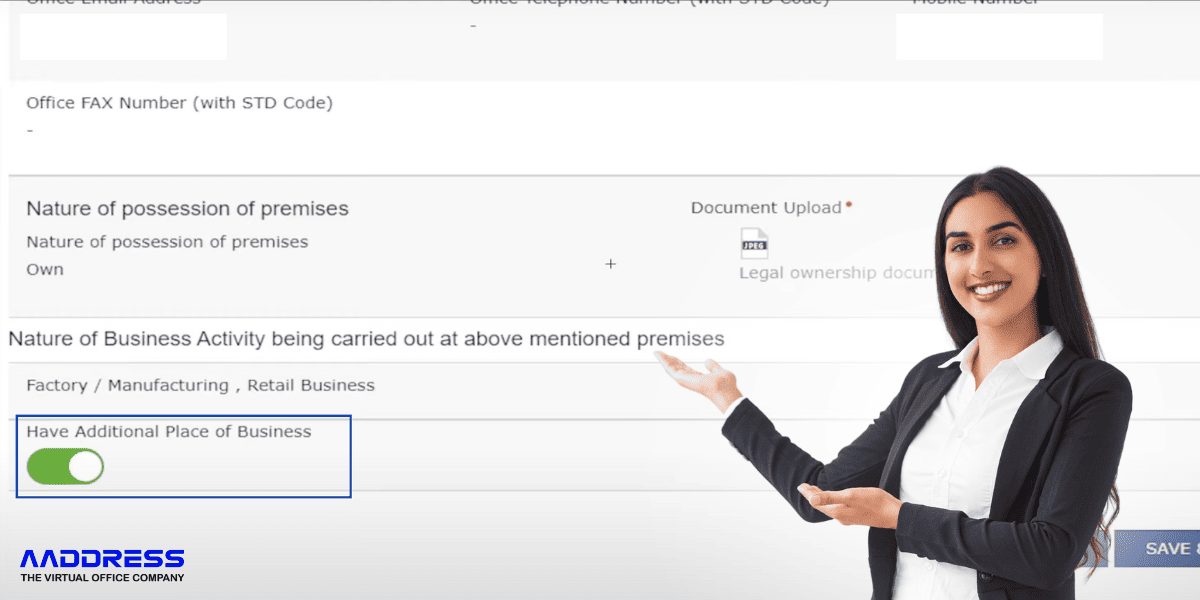Don’t just get a virtual office—let us help you build your business with our expert resources.Learn More
How to Start a Successful Food Business from Home: From Kitchen to Cash

Highlights:
-
- The Indian online food delivery market is projected to grow by 16.14% annually from 2024-2029, reaching a market volume of US$92.50 billion in 2029.
- The overall Food market in India is projected to grow by 7.67% from 2024-2029, resulting in a market volume of US$1,296.00 billion in 2029.
- By the end of 2020, the global online business market is forecast to reach $4.2 trillion. By 2024, online sales are expected to reach $6.5 trillion.
- The Indian internet food delivery business was estimated to be valued at $2.9 billion in 2020. Despite a 32% drop due to the COVID-19 pandemic, it is predicted to regain approximately 35% of its lost ground by 2025, reaching around $13 billion
Introduction:
In recent years, the food industry has witnessed a remarkable shift towards home-based businesses. This trend is fueled by a growing preference for homemade, artisanal, and health-conscious food options.
If you're passionate about cooking and want to turn your culinary skills into a profitable venture, starting a food business from home might be the perfect path for you.
In this comprehensive guide, we'll walk you through the essential steps to launch your home-based food business, covering everything from legal requirements to marketing strategies. We'll also explore how a virtual office can be a game-changer for home-based food entrepreneurs.
Source Credit: https://www.youtube.com/@aioram
Understanding the Home-Based Food Business Landscape
Benefits of Starting a Food Business from Home
Starting a food business from home offers numerous advantages:
Low Startup Costs: Operating from home eliminates the need for renting commercial kitchen space, significantly reducing overhead costs.
Flexibility: You can set your own hours and balance work with personal commitments.
Personal Touch: Customers often appreciate the unique, homemade touch that home-based food businesses offer.
Scalability: You can start small and gradually expand your business as demand grows.
Challenges to Consider
While there are many benefits, there are also challenges to be aware of:
Regulatory Compliance: Meeting health and safety regulations can be complex and varies by location.
Space Limitations: Your home kitchen may have limited capacity for large-scale production.
Marketing and Sales: Building a customer base and promoting your business requires effort and strategy.
Work-Life Balance: Running a business from home can blur the lines between personal and professional life.
Steps to Start Your Home-Based Food Business
1. Conduct Market Research
Before launching your food business, it's crucial to conduct thorough market research. This will help you understand the demand for your products, identify your target audience, and analyze your competition. Consider the following steps:
Identify Your Niche: Determine what type of food you want to offer. This could be baked goods, meal prep services, specialty diets (gluten-free, vegan, etc.), or ethnic cuisines.
Analyze Competitors: Look at other home-based food businesses in your area. What are they offering? What are their strengths and weaknesses?
Understand Customer Preferences: Conduct surveys or focus groups to gather feedback on potential products. What are your target customers looking for in terms of taste, quality, and price?
2. Develop a Business Plan
A well-structured business plan is essential for guiding your business and securing any necessary funding. Your business plan should include:
Executive Summary: An overview of your business, including your mission statement and objectives.
Market Analysis: A detailed analysis of your target market and competition.
Products and Services: A description of the food products you plan to offer.
Marketing Strategy: How you plan to promote your business and attract customers.
Operations Plan: Details on your production process, suppliers, and equipment needs.
Financial Projections: Revenue forecasts, budget, and funding requirements.
3. Comply with Legal Requirements
Operating a food business from home involves adhering to various legal and regulatory requirements. These may include:
Licensing and Permits: Obtain necessary business licenses and food handling permits from your local health department.
Cottage Food Laws: Many regions have cottage food laws that allow the sale of low-risk foods made at home. Familiarize yourself with these regulations.
Food Safety: Ensure your kitchen meets health and safety standards. You may need to complete a food safety certification course.
Zoning Laws: Check local zoning regulations to ensure you can operate a business from your home.
4. Set Up Your Home Kitchen
Transforming your home kitchen into a production-ready space involves several considerations:
Equipment: Invest in commercial-grade equipment if necessary. This could include ovens, mixers, refrigeration units, and packaging supplies.
Storage: Ensure you have adequate storage for ingredients and finished products.
Workspace: Create a dedicated workspace to maintain hygiene and efficiency.
Health and Safety: Implement strict hygiene practices, including regular cleaning and sanitizing.
5. Create a Brand Identity
Your brand identity sets you apart from competitors and helps attract customers. Consider the following elements:
Brand Name: Choose a memorable and relevant name for your business.
Logo and Packaging: Design a professional logo and attractive packaging that reflects your brand's personality.
Online Presence: Create a website and social media profiles to showcase your products and engage with customers.
6. Pricing Your Products
Pricing your products correctly is crucial for profitability. Consider the following factors:
Cost of Ingredients: Calculate the cost of ingredients for each product.
Production Time: Factor in the time it takes to produce each item.
Overhead Costs: Include expenses such as utilities, packaging, and marketing.
Competitor Pricing: Research what similar products are priced at in the market.
Profit Margin: Ensure your prices allow for a reasonable profit margin while remaining competitive.
7. Marketing and Selling Your Products
Marketing is key to attracting customers and growing your business. Here are some effective strategies:
Online Marketing: Utilize social media, email marketing, and your website to promote your products.
Local Advertising: Distribute flyers, participate in local events, and partner with nearby businesses.
Word of Mouth: Encourage satisfied customers to spread the word about your business.
Food Delivery Services: Partner with food delivery platforms to reach a wider audience.
8. Manage Finances and Operations
Efficiently managing your finances and operations is crucial for long-term success:
Accounting: Use accounting software to track income, expenses, and profits.
Inventory Management: Keep accurate records of inventory to avoid shortages or excess stock.
Customer Service: Provide excellent customer service to build loyalty and repeat business.
Continuous Improvement: Regularly seek feedback and make improvements to your products and processes.
The Role of a Virtual Office in Your Home-Based Food Business
A virtual office can provide significant advantages for home-based food entrepreneurs. Here's how:
1. Professional Business Address
A virtual office provides a professional business address, which enhances your brand's credibility. This is particularly important if you want to avoid using your home address for business purposes.
2. Mail Handling Services
Virtual offices often include mail handling services, ensuring that your business correspondence is managed efficiently. This can save you time and help you stay organized.
3. Meeting Spaces
If you need to meet with clients, suppliers, or investors, a virtual office can provide access to professional meeting spaces. This creates a more professional impression compared to meeting at a coffee shop or your home.
4. Call Handling Services
Many virtual offices offer call handling services, ensuring that your business calls are answered promptly and professionally. This can enhance customer service and free up your time to focus on other aspects of your business.
5. Scalability
As your business grows, a virtual office can provide the flexibility to scale your operations without the need for physical office space. This allows you to expand your business footprint without significant overhead costs.
6. Networking Opportunities
Virtual offices often house a diverse range of businesses, providing opportunities for networking and collaboration. This can lead to valuable business partnerships and new customer leads.
Conclusion
Starting a food business from home can be a rewarding and profitable venture if approached with careful planning and dedication.
By conducting thorough market research, complying with legal requirements, and implementing effective marketing strategies, you can turn your passion for cooking into a successful business.
Additionally, discovering the benefits of a virtual office can enhance your professionalism and streamline your operations, positioning you for long-term success.
Whether you're dreaming of selling homemade pastries, offering meal prep services, or creating specialty food products, this comprehensive guide provides the foundation you need to get started.
Embrace the journey with creativity and determination, and your home-based food business can thrive in the competitive culinary landscape.
Subscribe To Our Newsletter
Conquer your day with daily search marketing news.
Most popular Blogs
Top 5 Locations in Delhi to Set Up Your Virtual Office
When you start a business in Delhi, there's always that one uncle or friend who...
Read Full ArticleReading Time: 5 min.How to Start Water Bottle Business in India: A Practical Guide
Starting a water bottle business in India can be a smart and rewarding move. ...
Read Full ArticleReading Time: 4 min.How to Add Additional Place of Business in GST Online (2025 Guide)
Adding an additional place of business in GST is mandatory for each business if they...
Read Full ArticleReading Time: .Low-Cost Business Ideas with High Profit
Introduction Starting your own business is becoming a popular choice for many people today....
Read Full ArticleReading Time: .



